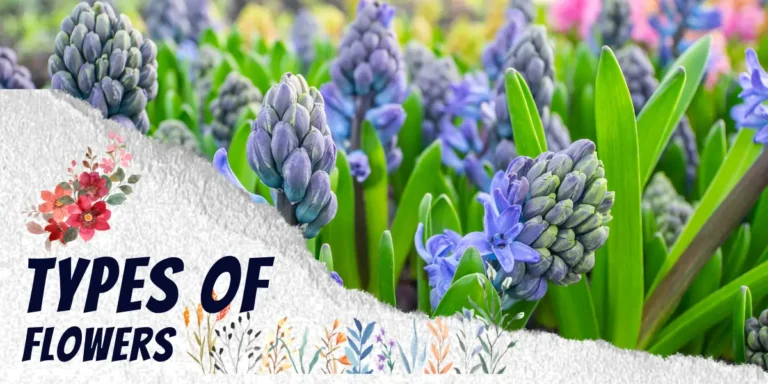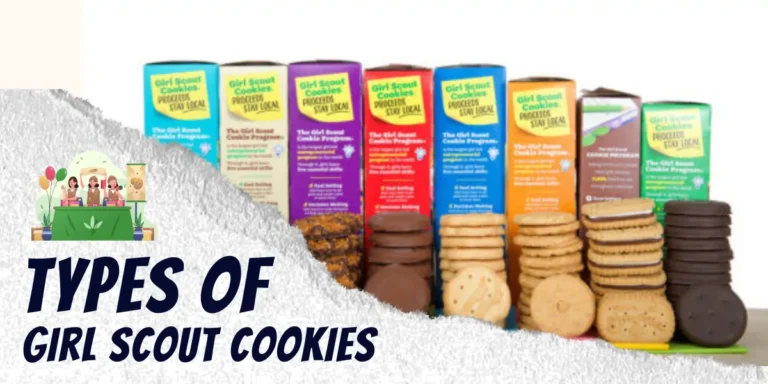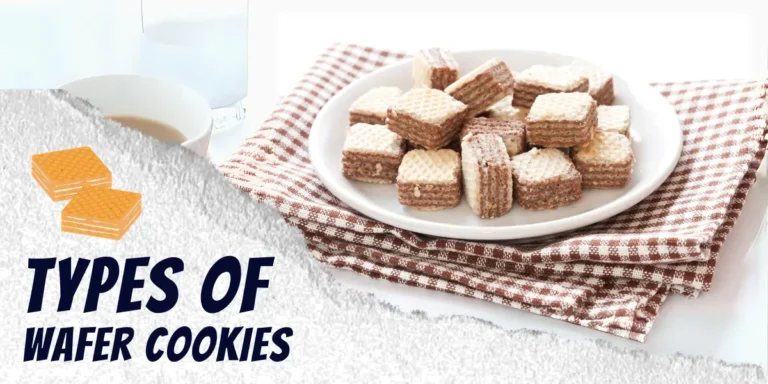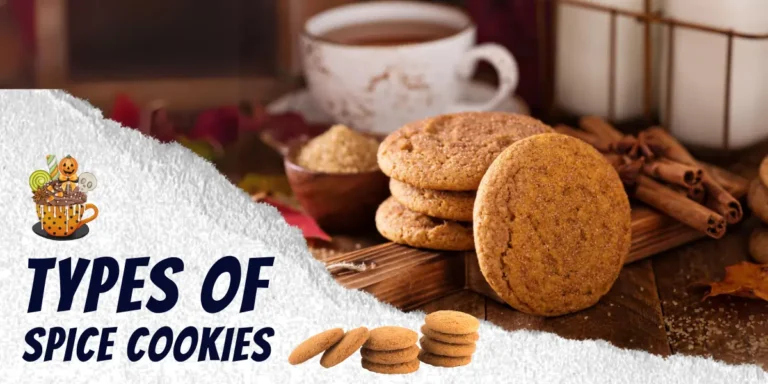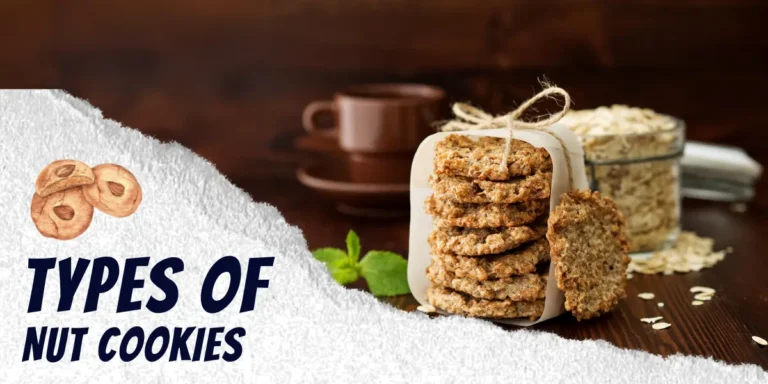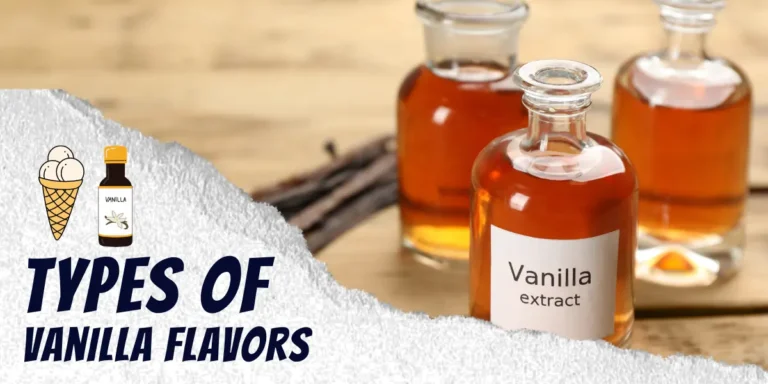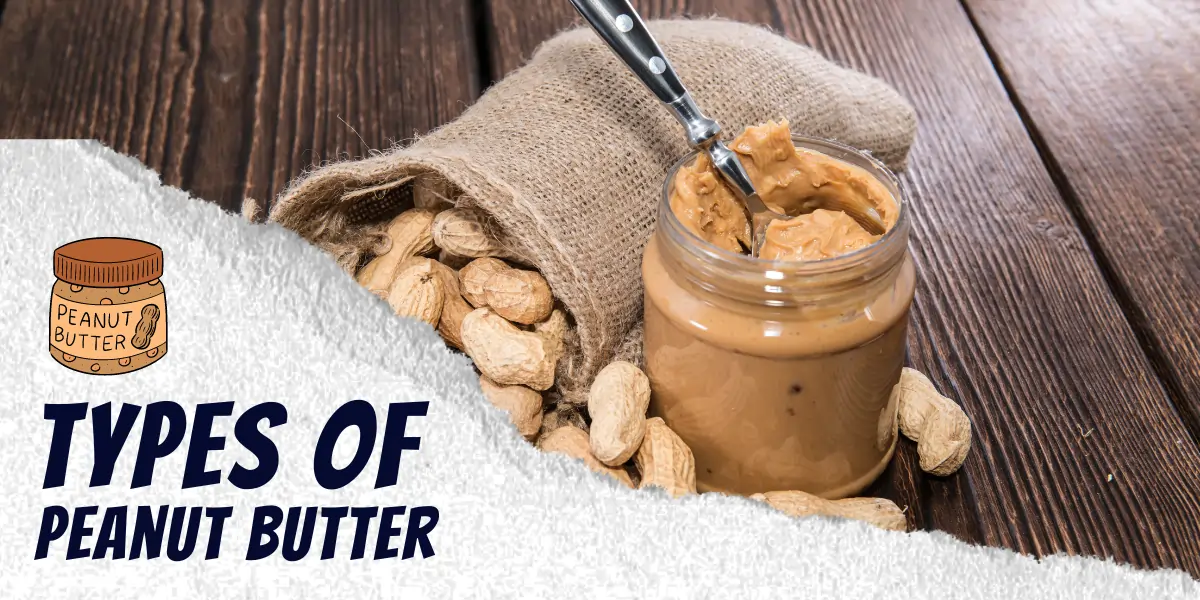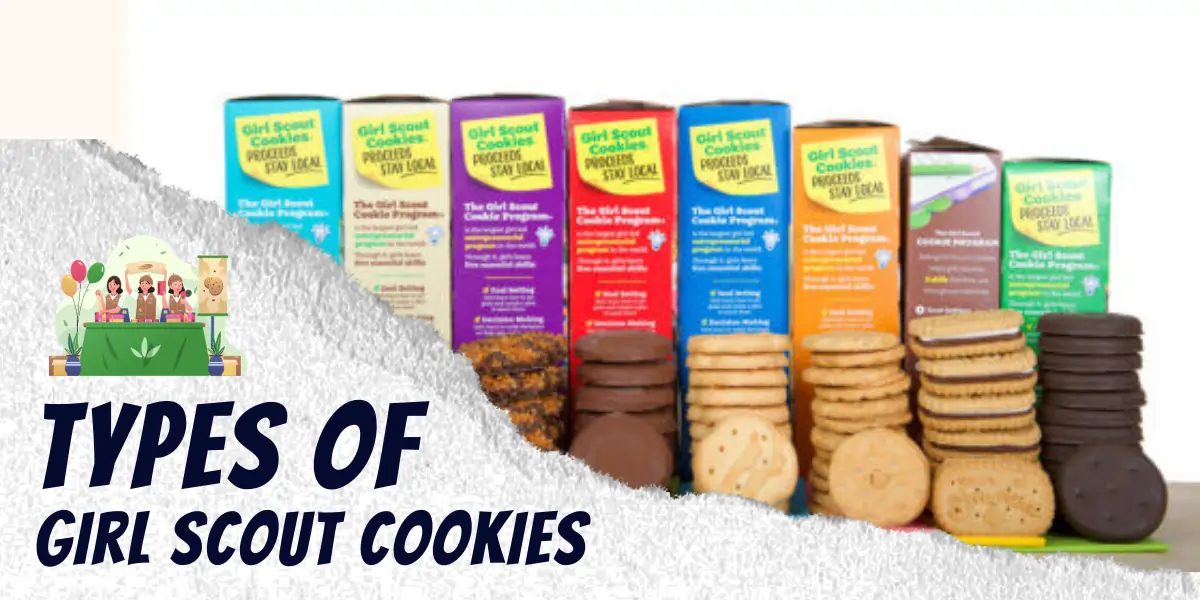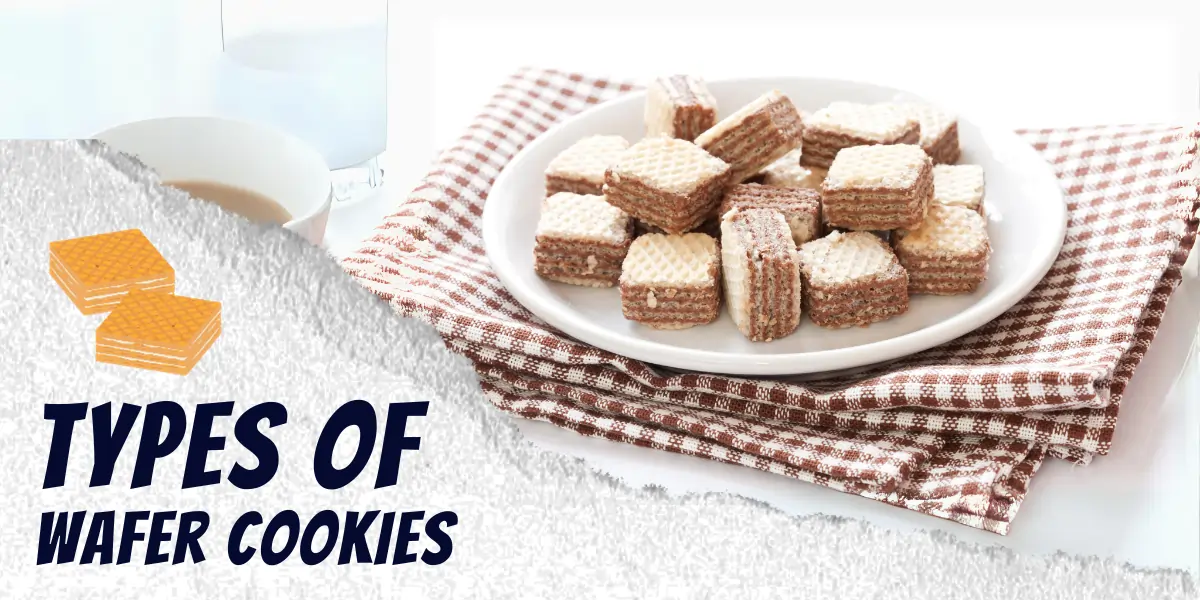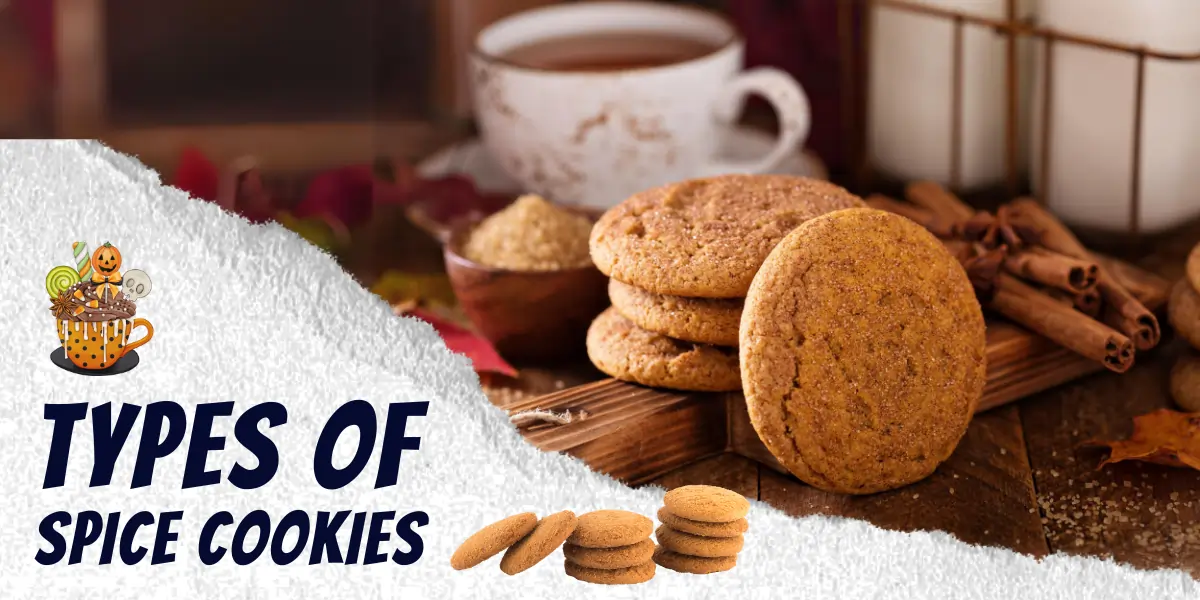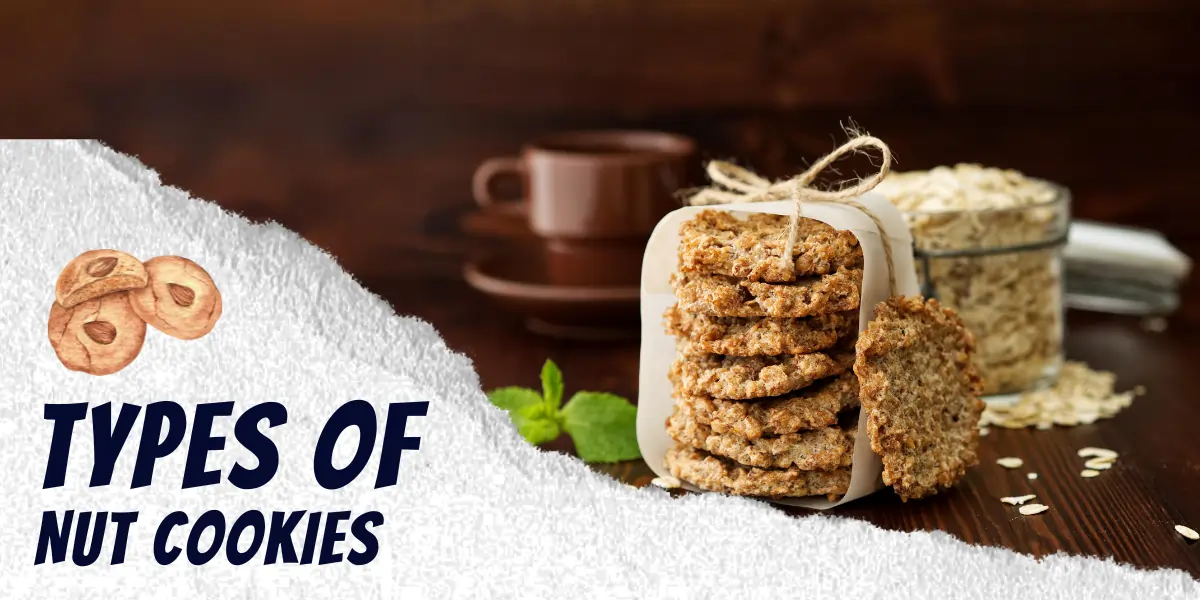Peanut butter – creamy, crunchy, sweet, salty, nutty goodness in a jar. Over 95% of American households keep a jar of PB on hand for everything from classic sandwiches to nutritious snacking to dessert inspiration. And an astounding 700 million pounds gets churned out annually just in the US alone.
But for all its mass appeal, few peanut butter lovers realize just how diverse their options are these days. Behind the familiar JIFs and SKIPPYs on grocery shelves lurks a fast expanding world of artisanal nut butters, international styles, alternative bases and experimental flavors.
Life offers too few perfect foods not to fully appreciate one as awesome as peanut butter. So grab a jar (or three) and let’s dig in to discover all the distinctive types ideal for spreading joy and sticky smiles across every meal.
Table of Contents
A Brief History of Peanut Butter Rise
While Asian and African cultures enjoyed mashed peanuts and nut pastes for centuries, peanut butter as its own defined food emerged surprisingly recently in America.
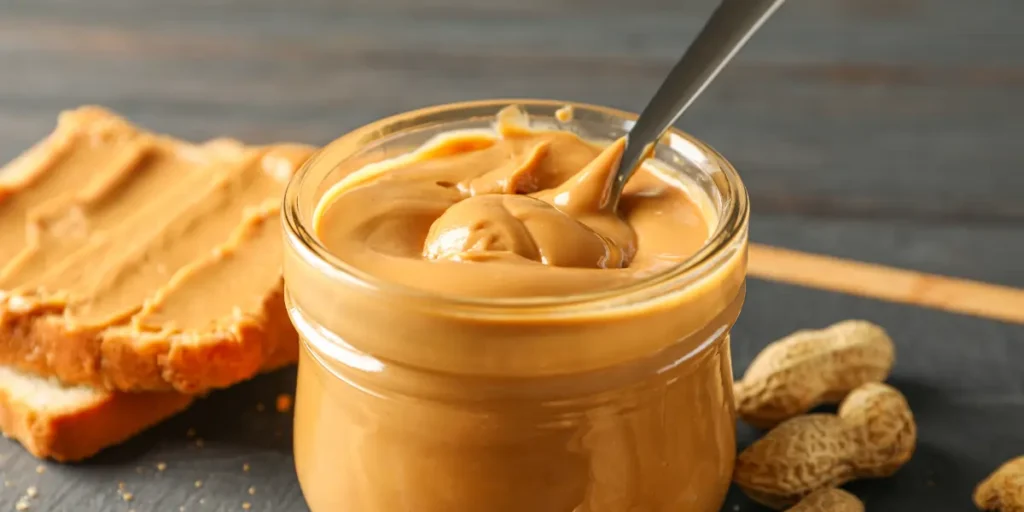
- Origins – Credited to food chemist George Washington Carver in 1890s as a protein substitute for those lacking access to nutritious meat options
- Early Days – Sold as a health food, thought of as a luxury for middle and upper class
- Mass Market – Jif launches first national campaign in 1950s marketing PB to average consumer
- Crunchy Arrives – SKIPPY introduces crunchy style peanut butter in 1933 satisfying texture preferences
- Steady Innovation – New styles like no-stir, reduced fat, alternative nut options expand category
- Artisanal Wave – Small batch peanut butters focus on premium ingredients and experimental flavors
Now that it’s secured a treasured place in pantries globally, let’s appreciate the different types of peanut butter styles that emerged thanks to creative food makers and consumer demand for options. Onward to tastiness!
The Central Stylistic Divisions
While seemingly a simple spread, peanut butter actually covers a spectrum of stylistic interpretations. Most peanut butter types fall into one of three camps:
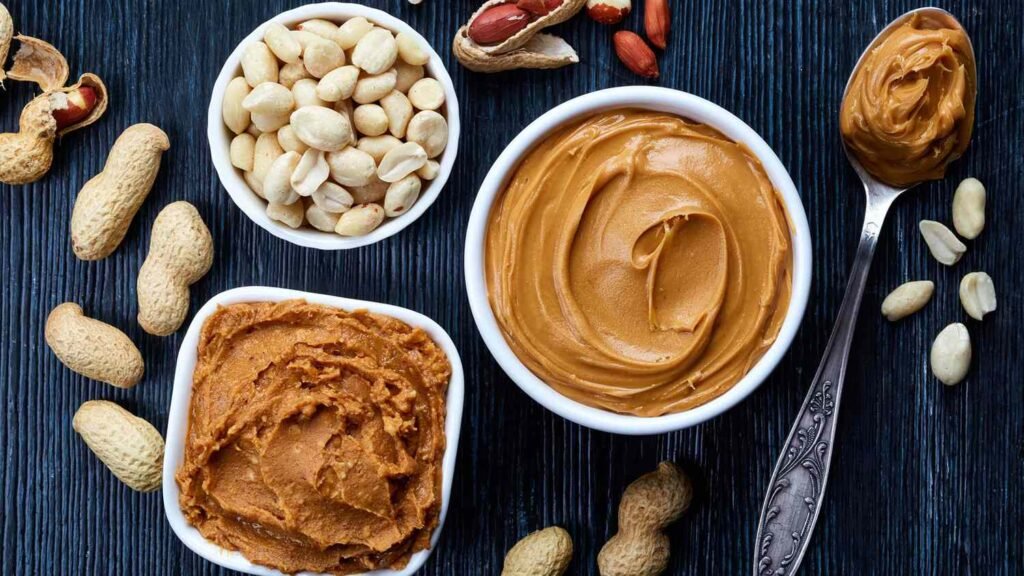
Creamy
- Smooth, uniform texture
- No visible nut pieces or texture
- Slightly denser and richer
- Allows flavors to meld together
Crunchy
- Chunks of peanuts interspersed
- Adds more defined nutty bite
- Offers contrasting crunch
- Extra surface area equals more flavor
Natural
- 100% peanuts and salt the only ingredients
- No added oils, sugars, emulsifiers
- Peanut oils keep it spreadable
- Deep roasted peanut flavor
- Oil separation likely
Now let’s explore how factors like ingredients, texture techniques, intended use and creative riffing different types of peanut butter options within (and around) those general divisions.
Types of Peanut Butter by Base Composition
Believe it or not, not all peanut butter types contains just peanuts! Let’s review the main compositional styles:
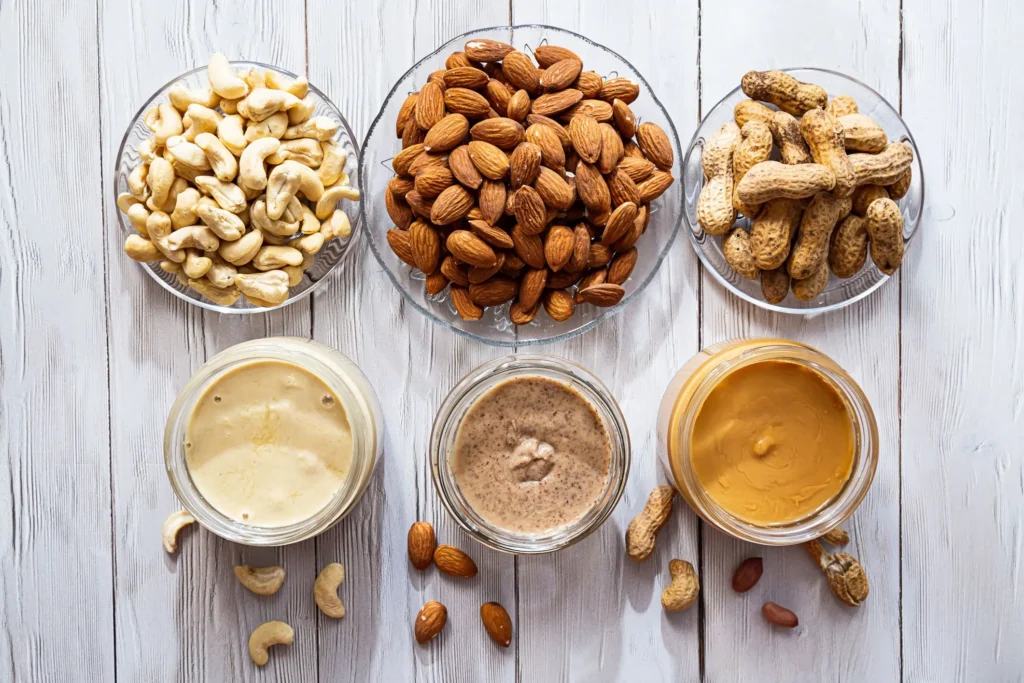
Classic Peanut Butter
This traditional peanut butter style simply purees roasted peanuts into paste with a sprinkling of salt to boost flavor. Many conventional and organic brands stick to this simple approach. Though textures vary, ingredients stay straightforward – just nuts.
- 90-100% roasted peanuts
- Salt for flavor
- Smooth or crunchy textures
- Most versatile option
Sweetened Peanut Butter
Geared towards dessert usage, sweetened peanut butter incorporates sugar to amp up sweet appeal. Amounts range from a couple teaspoons to up to 4 tablespoons per standard jar. This type of peanut butter is popular in baking or eating straight from the spoon.
- Peanuts + white/brown sugar
- Occasional extra sweeteners like honey
- Creamy texture predominant
- Label may specify no need to stir
Reduced Fat Peanut Butter
For the health conscious or weight watching, reduced fat peanut butter type cuts some of the lipid load. But how to do that with pure nuts? Simple – add filler starches.
- Partial peanuts swapped for starches
- Typically uses corn or potato starch
- Leaner nutritional stats
- Less intensely nutty taste
Alternative Nut Butters
Beyond peanuts, all types of nuts and seeds can produce spreadable nut butter. Each offers its own unique flavor and texture when ground into paste.
- Almond butter
- Cashew butter
- Sunflower seed butter
- Mixed blends
- Great for those with peanut allergies
How Production Method Affects Peanut Butter Type
Commercial scale peanut butter makers must decide optimal techniques balancing cost, efficiency, and quality. Common options include:
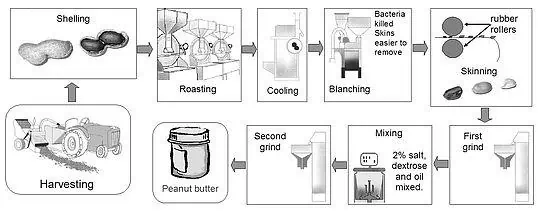
Cold Pressed
- Gentler milling keeps texture chunkier
- Heat damage avoided preserving nutrition
- Retains more peanut oils = superior nutty essence
- Shorter shelf life
Hot Roasted
- Intense heat roasting coaxes out oils
- Boosts toasty, roasted peanut flavors
- Bolder, deeper flavor dimension
Fast Shear
- Aggressive shear pulverizing
- Yields extremely smooth creamy texture
- Peanut essence diluted/degraded
- Cheapest manufacturing option
Low Temperature Extrusion
- Gentle warming opens up peanut cell structure
- Loosens nut solids from oils without damaging
- Creamy texture with improved mouthfeel
- Pricier but preserves quality
Different Types of Peanut Butter by Intended Usage
Beyond composition and process factors, peanut butter types also emerge based on common usage purposes and scenarios:
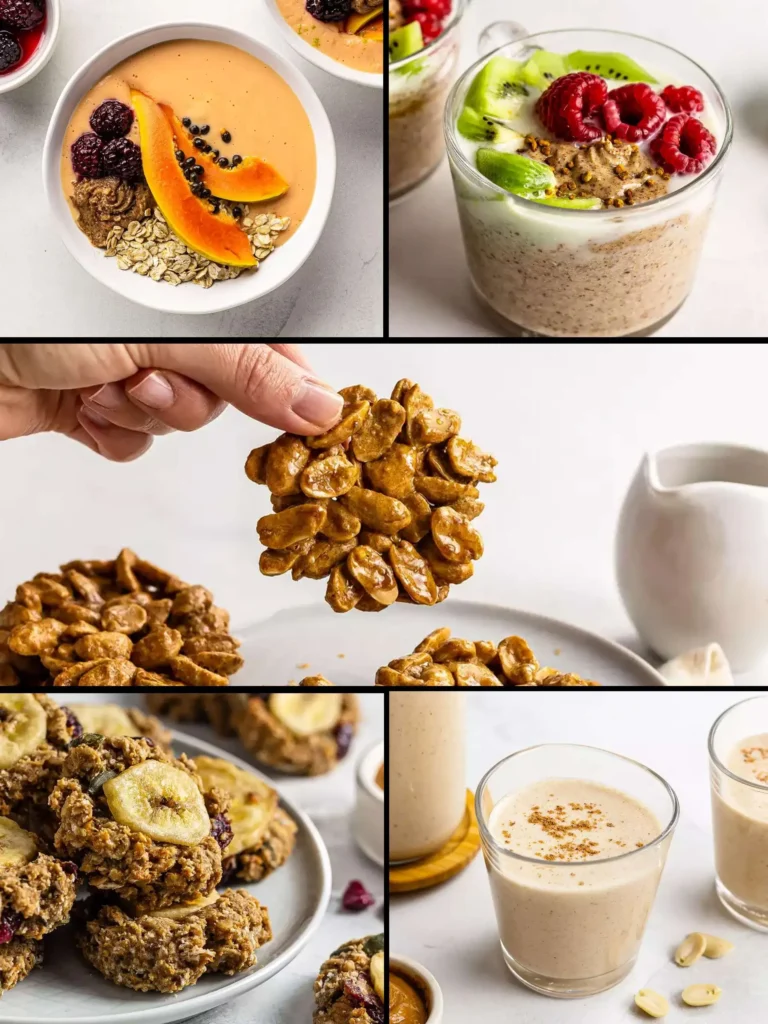
Sandwich Spreads
Classic smooth or crunchy styles intended for everything from good ol’ PB&Js to grilled sandwiches excel as spreads thanks to balanced moisture and easy spreadability.
Baking Staples
Peanut butter’s high protein and healthy fats make it a phenomenal ingredient for boosting nutrition in baked goods. Sweetened and alternative nut butters commonly fill this role.
Snacking Choices
Convenient ready to eat peanut butter paired with crackers, pretzels, apples or alone covers on the go oral fixations. Portable packs reign supreme.
Protein Boosters
Serious gym goers and athletes have embraced powdered peanut butter as the perfect way to add plant-based protein to shakes and smoothies without altering texture.
Confectionery Inclusions
From peanut butter cups to buckeyes to bonbons, candy makers adore rich, creamy peanut butter as a mixing addition or filling star.
Peanut Butter Types by Flavor Profile

Beyond classic roasted peanut flavor, peanut butter also dresses up in all sorts of flavor variations to satisfy adventurous appetites. Some top examples include:
| Sweets Inspired | Fruit Focused | Global Journey | Seasonal Spotlight | Savory Surprise | Eccentric Edges |
|---|---|---|---|---|---|
| Chocolate infused | Raspberry ribboned | Thai chili kicked | Pumpkin spiced | Bacon blended | Black lava sea salt topped |
| Vanilla swirled | Strawberry swirled | Indian curry spiced | Peppermint swirled | Beer battered | Ghost pepper infused |
| Cookie dough chunked | Cherry chunked | European hazelnut swirled | Gingerbread spiced | Maple syrup sweetened | Charcoal blackened |
| Banana blended | Blueberry blended | West African palm oiled | Eggnog flavored | Coffee awakened | Pickle juice fortified |
| Honey sweetened | Orange zested | ||||
| Cinnamon spiced | Coconut creamed |
Now that our heads are spinning with the diverse stylistic interpretations available, let’s directly compare some key factors to help match preferences with the right peanut butter choice!
Key Characteristics Comparison
| Type | Texture | Ingredients | Taste Intensity | Separation Likely | Best Uses |
|---|---|---|---|---|---|
| Creamy | Smooth, uniform | Peanuts, salt, sweeteners, emulsifiers | Medium | No | Sandwiches, baking, smoothies |
| Crunchy | Chunky peanut pieces | Peanuts, salt | High | No | Snacking, topping baked goods |
| Natural | Varies | Just peanuts and salt | Very high | Yes | Healthful snacking, smoothies |
| Reduced fat | Creamy | Peanuts, starches, sugar | Mild | Maybe | Health conscious eating |
| Alternative nut | Varies | Almonds, cashews, seeds | Nut dependent | Likely | Great for nut allergies |
| Sweetened | Creamy | Peanuts, tons of sugar | Very sweet | Unlikely | Candy making, desserts |
| Cold pressed | Coarse chunks | Peanuts, salt | Robust | Quicker than most | Nutritional preservation |
| Spiced/flavored | Typically creamy | Peanuts, mix-ins like cocoa, spices | Range across types | Depends on composition | Desserts, gift giving |
The Pros and Cons of Each Variant
Love all peanut butter options? Have strong opinions or texture issues? Understanding the inherent trade-offs helps match preferences.
Creamy
- Pros: Smooth, uniform texture, no mixing required, allows flavors to blend
- Cons: Less peanut flavor, unsightly oil separation likely in natural
Crunchy
- Pros: Peanut pieces provide nice contrast, chomping fun
- Cons: Needs robust stirring, bits stuck in teeth likely outcome
Natural
- Pros: Simple real ingredients, intense nutty essence
- Cons: Oil separation pains, not quite as spreadable
Reduced Fat
- Pros: Fewer calories and fat if watching weight
- Cons: Diluted peanut flavor, more processed feel
Alternative Nut
- Pros: Incredible for peanut allergy avoidance, unique flavors
- Cons: Often pricier, not quite as versatile in recipes calling for peanut
Sweetened
- Pros: Custom calibrated for candy/dessert usage
- Cons: Too sweet for sandwiches or snacking for some
Cold Pressed
- Pros: Retains more nutrients and oils = superior nutty richness
- Cons: Shorter shelf life, pricier production
Spiced/Flavored
- Pros: Fun flavor adventures, gift potential
- Cons: Risks masking quality of base nuts, “too weird” for some
Different Types of Peanut Butter Recipes
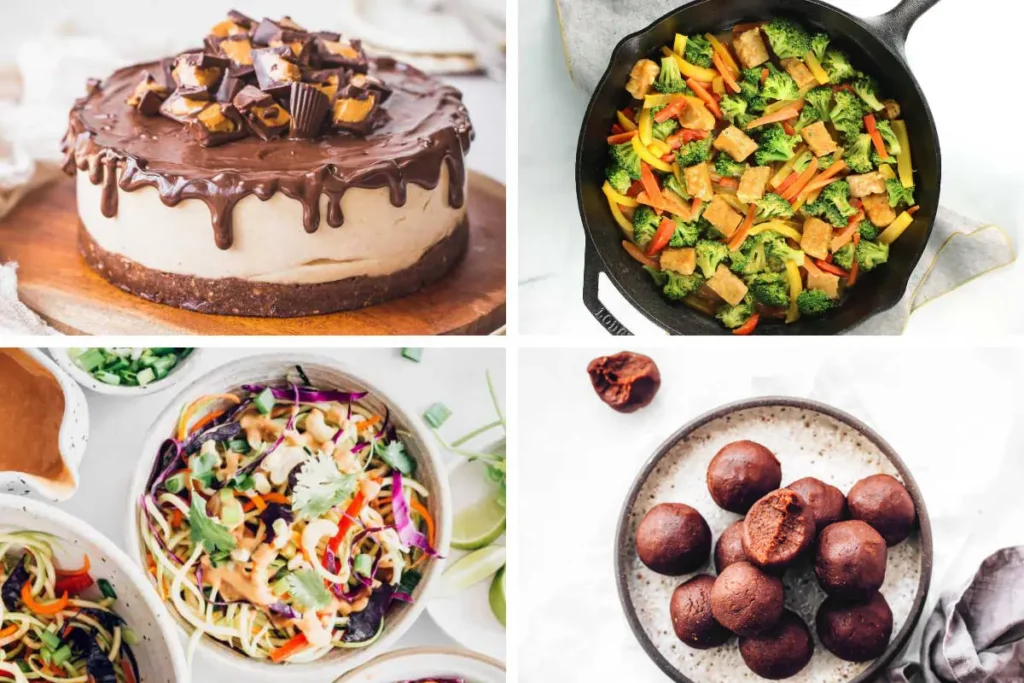
While peanut butter offers reliable pleasure across meals and cravings, some types fit specific usage occasions better.
| Peanut Butter Type | Example Recipes |
|---|---|
| Creamy | Smoothies, Asian peanut sauces, fudgy peanut butter desserts, cookie doughs |
| Crunchy | Trail mixes, topping waffles/pancakes, ice cream mix-in, peanut brittle, textured cookies |
| Natural | Homemade granola, fruit and nut bars, stir fries, satay peanut sauce |
| Sweetened | Buckeye candies, peanut butter fudge, milkshake booster, cookie fillings, frostings |
| Alternative Nut | Seed and nut crusts, nut milks, nut-based hummus, pestos |
| Powdered | Protein shakes, smoothies, energy bite boosting |
| Cold Pressed | DIY nut butter at home, preserve raw essence |
Types of Peanut Butter Sandwiches
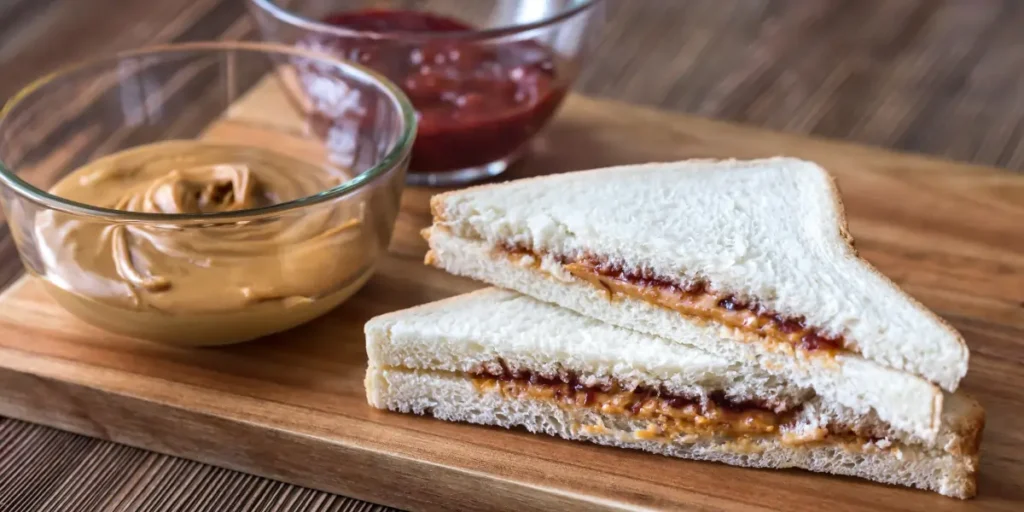
When it comes to building the perfect peanut butter sandwich, the style of peanut butter greatly impacts the experience. Here are some top tandem pairings:
| Peanut Butter Type | Sandwich Pairings |
|---|---|
| Creamy | Classic PB&J, Elvis (with banana and bacon), peanut butter and honey |
| Crunchy | Peanut butter and jelly, grilled cheese (peanut butter adds texture contrast), peanut butter and marshmallow fluff |
| Natural | Asian banh mi fusions, peanut butter and seasonal fruit jam |
| Alternative Nut | Almond butter with tart apple slices and honey; cashew butter with jelly |
| Sweetened | Extra sweet peanut butter with marshmallow fluff |
| Spiced/Flavored | Pumpkin spiced peanut butter with cream cheese and pepper jelly on pumpkin bread |
Types of Peanut Butter Cookies
Given peanut butter’s starring role in cookies, styles with intensified peanut flavor or richer fudgy body tend to excel. Here are some of the most popular types of peanut butter cookies:
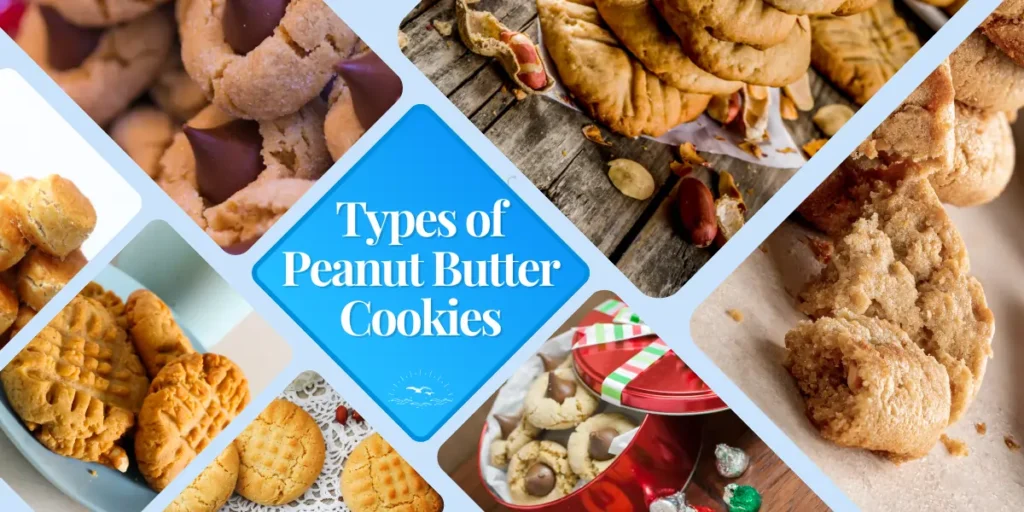
- Classic Peanut Butter Cookies – The classic recipe with peanut butter, sugar, eggs, and flour. Often made with crisscross fork marks on top.
- Chocolate Peanut Butter Cookies – Peanut butter cookies with chocolate chips mixed throughout the dough. May also drizzle melted chocolate on top.
- Peanut Butter Blossoms – A peanut butter cookie base topped with a Hershey’s chocolate kiss candy, creating a “blossom” shape when baked. The chocolate kiss gets soft and gooey.
- Peanut Butter Cup Cookies – These types of cookies made by stuffing a mini Reese’s peanut butter cup inside a dollop of peanut butter cookie dough and baking.
- Peanut Butter Crinkles – Rolled in granulated sugar before baking, these cookies get that signature crinkly sugary topping cracked over the surface.
- No-Bake Peanut Butter Cookies – Using peanut butter, powdered sugar, and other ingredients, these cookies set up in the fridge instead of the oven.
- Flourless Peanut Butter Cookies – For gluten-free diets, these use no flour, getting structure from peanut butter and eggs instead.
- Vegan Peanut Butter Cookies – Dairy-free and egg-free, these use peanut butter with vegan ingredients like flax eggs, oat flour, etc.
- Thai Peanut Butter Cookies – With Thai red curry paste and coconut milk added for a savory, spicy cookie with Southeast Asian flair.
Baking with Peanut Butter: Recipes and Tips
Peanut butter is a versatile ingredient that can be used in a variety of baked goods. Here are some recipes and tips for baking with peanut butter:
Peanut Butter Cookies
- Ingredients: Classic peanut butter cookies often include all-purpose flour, unsalted butter, peanut butter, brown sugar, granulated sugar, vanilla extract, egg, and baking powder.
- Instructions: Cream together butter and sugars, add peanut butter, then mix in the egg and vanilla. Combine the dry ingredients separately and gradually add to the wet mixture. Roll dough into balls, place on a baking sheet, and press with a fork to create a crisscross pattern. Bake until golden.
- Tips: For a soft and velvety crumb, use creamy peanut butter. If using natural peanut butter, ensure it’s well mixed before adding.
Homemade Peanut Butter
- Ingredients: Making your own peanut butter requires just peanuts and optional salt. Some recipes may include oil for a smoother texture.
- Instructions: Process the peanuts in a food processor until smooth, scraping down the sides as needed. Store in an airtight container.
- Tips: No additional oil is necessary as the peanuts will release their natural oils during processing. Be patient; it can take several minutes to achieve a creamy consistency.
Peanut Butter Fudge
- Ingredients: Peanut butter fudge can be made with butter, peanut butter, powdered sugar, and vanilla extract.
- Instructions: Melt butter and peanut butter together, then mix in powdered sugar and vanilla until smooth. Spread into a pan and chill until set.
- Tips: For a richer flavor, you can add chocolate chips or nuts. Adjust the sweetness to your liking.
Peanut Butter Variations in Baking
- Flavored Peanut Butter: Incorporate different flavors into your peanut butter baked goods, such as chocolate, honey, or cinnamon.
- Nut Butter Alternatives: Almond butter, cashew butter, or sunflower seed butter can be used in place of peanut butter for those with allergies or preferences.
- Healthier Options: For a healthier take, use natural peanut butter without added sugars or oils and substitute some of the all-purpose flour with whole wheat or oat flour.
Peanut butter adds a rich, nutty flavor to baked goods and can be used in both sweet and savory recipes. Whether you’re making cookies, fudge, or homemade peanut butter, there are endless possibilities for incorporating this beloved spread into your baking repertoire.
Types of Peanut Butter in Ice Cream
Creamy, fatty, and sweet – peanut butter feels right at home churned into ice cream. Usages include:
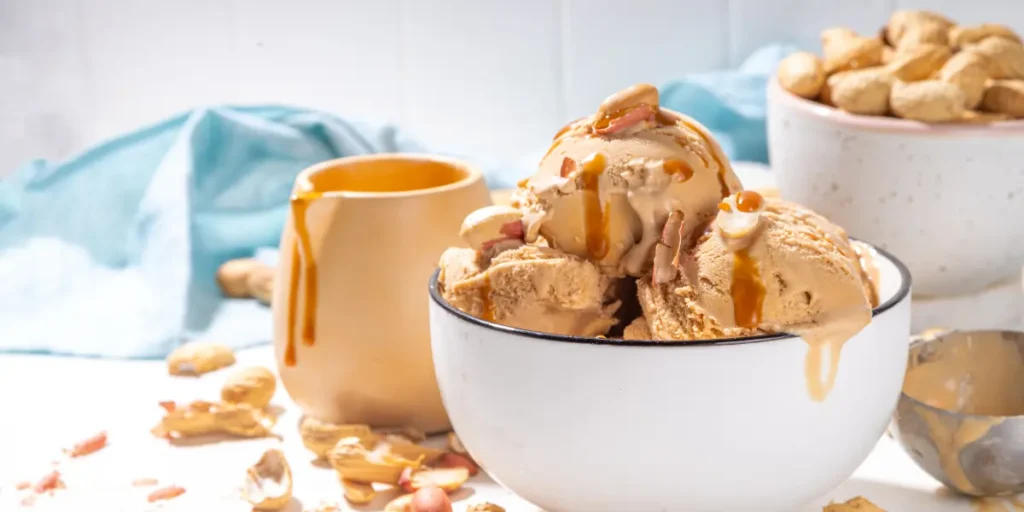
- Swirls of softened peanut butter ribbon through plain vanilla or chocolate ice cream base
- Chocolate chunks studded with peanut butter cups mix in for textures
- Peanut powder blended into base and softened peanut butter dolloped on top
- Thai flavors with coconut milk base and ginger peanut butter swirls
- Banana ice cream with crunchy bits and plenty of sweetened peanut butter
here are some types of peanut butter in ice cream:
- Blended Peanut Butter Ice Cream: Häagen-Dazs Chocolate Peanut Butter ice cream is noted for blending the peanut butter into the product rather than having visible chunks, which offers a distinct peanut butter taste.
- Salted Peanut Butter: The unique feature of salted peanut butter in ice cream, as mentioned in Häagen-Dazs’s product, can be highlighted. The salt enhances the flavor and provides a balance to the sweetness.
- Keto-Friendly Options: Halo Top’s Peanut Butter Cup ice cream is mentioned as part of their keto offerings, indicating that there are low-carb peanut butter ice cream options available for those following a ketogenic diet.
- Homemade Varieties: The search results suggest that homemade peanut butter ice cream can be made with a simple base of peanut butter, half and half, sugar, salt, and vanilla, without the need for eggs or cooking a custard.
- Candy-Inspired Flavors: Recipes for peanut butter ice cream that mimic popular candy bars, such as Snickers or Peanut Butter Cups, can be created by adding ingredients like roasted peanuts, chocolate, and caramel.
- Artisanal and Organic Options: The blog post mentions the diversity of peanut butter options, including artisanal and organic varieties, which can be used to create gourmet peanut butter ice creams.
- Nutritional Aspects: Peanut butter’s high protein and healthy fats make it a nutritious addition to ice cream, which can be emphasized in the content.
- Frozen Treat Bars: KIND offers a frozen treat bar that includes peanuts, chocolate chunks, and chopped nuts layered with smooth nut butter, showcasing another way peanut butter can be enjoyed in frozen desserts.
These points can be used to expand on the types of peanut butter in ice cream, highlighting the variety of flavors, textures, and nutritional options available to consumers.
Types of Peanut Butter Brands
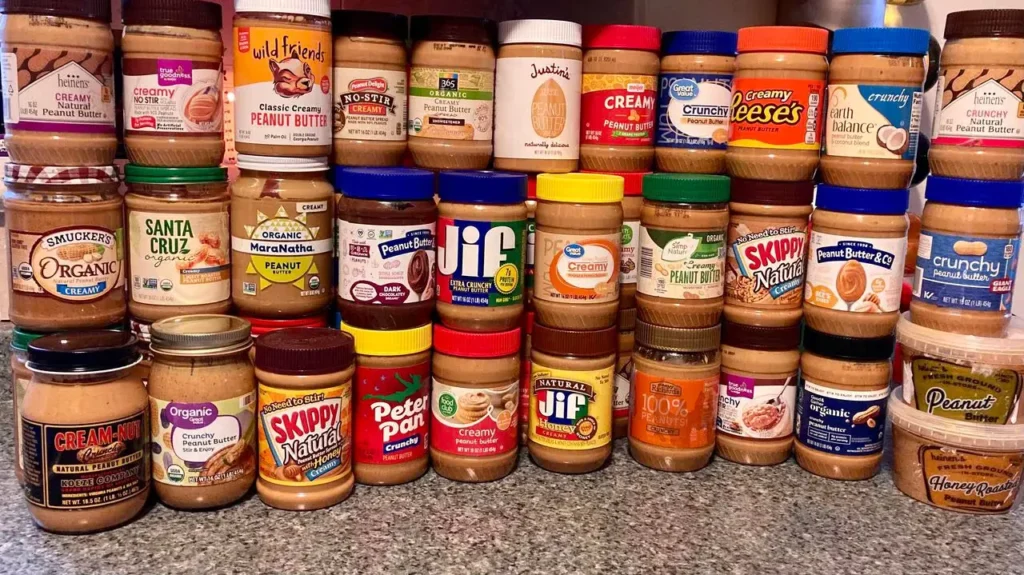
While small batch artisanal nut butter makers expand options, classic American brands still dominate shelves .Here are some of the major brands and types of peanut butter:
- Jif – One of the most popular mainstream peanut butter brands. Makes creamy and crunchy varieties. Also have reduced fat options.
- Skippy – Another well-known classic peanut butter brand. Offers creamy, crunchy, natural, and reduced fat options.
- Peter Pan – Known for their classic creamy and crunchy peanut butters. Owned by Conagra.
- Reese’s – Made by Hershey’s, these peanut butters have a sweet flavor profile to mimic the Reese’s peanut butter cup candy flavor.
- Smucker’s – Offers natural creamy and crunchy organic peanut butters. Also makes peanut butter spreads.
- Justin’s – An organic peanut butter brand focused on nut butters. Makes creamy, crunchy, honey, and specialty blends.
- Teddie – Known for super smooth and silky all natural peanut butters. Offered in creamy and crunchy.
- Trader Joe’s – Their house brand Creamy Salted Valencia Peanut Butter has a cult following. Also sell other peanut butter varieties.
- Smart Balance – Uses a blend of oils to create more trans fat free and cholesterol free peanut butter options.
- Adams – Known for making all natural peanut butters as well as other nut-based and seed spreads.
Peanut Butter Curry: Variations and Recipes
Peanut butter curry is a rich and flavorful dish that combines the creamy texture of peanut butter with the aromatic spices of curry. Here are some variations and recipes to consider:
Classic Peanut Butter Curry
- Ingredients: Start with sautéing onions, garlic, and ginger. Add spices like paprika, cayenne pepper, and curry powder. Stir in tomato puree, coconut milk, and peanut butter to create a creamy sauce. Add your choice of protein or vegetables.
- Variations: For a vegan option, use chickpeas or tofu. Add spinach or kale for extra greens.
Thai Peanut Butter Curry
- Ingredients: This version often includes red curry paste, coconut milk, peanut butter, and a sweetener like brown sugar or maple syrup. It may also contain lime juice and soy sauce for tanginess and umami flavor.
- Variations: Incorporate different vegetables like sweet potatoes, bell peppers, or broccoli. Add chicken or shrimp for a non-vegetarian version.
Sweet Potato Peanut Butter Curry
- Ingredients: Combine diced sweet potatoes with curry and tomato pastes, coconut milk, and peanut butter. Cook until the potatoes are tender.
- Variations: Add other root vegetables or use almond butter for a different nutty flavor.
Spicy Peanut Butter Curry
- Ingredients: Use ingredients like red chili pepper, ginger, and garlic to create a spicy base. Add peanut butter and coconut milk for creaminess.
- Variations: Adjust the level of heat with more or less chili. Use different proteins like beef or pork.
Peanut Butter Chicken Curry
- Ingredients: Brown chicken thighs, then cook with onions, garlic, and spices. Mix in peanut butter, coconut milk, and tomatoes for the sauce.
- Variations: Substitute chicken with other meats or use a combination of vegetables for a vegetarian dish.
Slow Cooker Peanut Butter Curry
- Ingredients: Combine all ingredients in a slow cooker and let it cook for several hours until the flavors meld together and the meat is tender.
- Variations: Try different types of nut butter or add a splash of fish sauce for extra depth.
Quick Peanut Butter Curry
- Ingredients: For a fast meal, use pre-cooked protein like rotisserie chicken and quick-cooking vegetables. Mix with peanut butter, coconut milk, and curry spices.
- Variations: Use pre-made curry paste to save time and add a variety of stir-fry vegetables.
When making peanut butter curry, consider using natural peanut butter to avoid added sugars and oils. Also, adjust the thickness of your curry by adding more or less coconut milk, and sweeten to taste with natural sweeteners like honey or maple syrup.
Experiment with different add-ins and toppings to make your curry your own. Enjoy your rich and flavorful peanut butter curry!
Peanut Butter Noodles: Variations and Recipes
Peanut butter noodles are a versatile and flavorful dish that combines the creamy texture of peanut butter with the savory taste of noodles. Here are some variations and recipes to consider:
Classic Peanut Butter Noodles
- Ingredients: This version often includes ingredients like spaghetti or ramen noodles, peanut butter, soy sauce, garlic, ginger, and a variety of vegetables for added texture and flavor.
- Variations: For a gluten-free option, use gluten-free spaghetti or rice noodles. You can also add different types of vegetables or proteins like chicken or tofu to make the dish more substantial.
Spicy Peanut Butter Noodles
- Ingredients: This variation adds a kick with the inclusion of chili flakes or hot pepper sauce. Other ingredients typically include ramen noodles, sesame oil, garlic, and a crumbled stock cube.
- Variations: Adjust the level of spiciness to your preference by adding more or less chili flakes or hot pepper sauce. You can also add leftover shredded cooked chicken, beef, or other proteins to make it a more filling meal.
Thai Peanut Butter Noodles
- Ingredients: This version often includes ingredients like rice noodles, peanut butter, soy sauce or tamari, garlic, and a variety of vegetables. It also typically includes a unique blend of Thai flavors like lime juice and Sriracha hot sauce.
- Variations: To make this dish gluten-free, use tamari instead of soy sauce. You can also add different types of vegetables or proteins like edamame or tofu to make the dish more substantial.
Quick and Easy Peanut Butter Noodles
- Ingredients: This version is perfect for those who are short on time. It typically includes ingredients like instant ramen noodles, peanut butter, sesame oil, and a variety of quick-cooking vegetables.
- Variations: You can use different types of noodles like spaghetti or rice noodles. You can also add different types of vegetables or proteins to make the dish more substantial.
Remember, these recipes are flexible and can be adjusted to suit your personal taste preferences. Enjoy experimenting with different variations of peanut butter noodles!
Peanut Butter Soup: Variations and Recipes
Peanut butter soup is a comforting and rich dish that is popular in various cuisines, particularly in West African countries. Here are some variations and recipes to consider:
West African Peanut Soup
- Ingredients: This soup typically includes peanut butter, tomato paste, onions, ginger, sweet potatoes, and vegetable broth or water. It may also contain spices like cayenne pepper or chili peppers for added heat[1].
- Variations: Some recipes add chicken or use different vegetables like carrots or kale. Adjust the spiciness to your preference[1][3].
African Peanut Soup with Chickpeas
- Ingredients: A vegan version of the soup might include chickpeas, ginger, garlic, and chilies in a creamy peanut tomato base. It’s often garnished with crushed peanuts and cilantro[2].
- Variations: You can serve it as a soup or over cooked whole grains for a hearty meal. Add cooked chicken or crispy tofu for more protein[2].
Creamy Peanut Soup
- Ingredients: For a creamier version, some recipes use heavy cream along with peanut butter, chicken stock, celery, onion, and lemon juice[7].
- Variations: To make it thicker, replace some of the chicken stock with more heavy cream. Serve it with a tossed salad or sandwich for a complete meal[7].
Ghanaian Peanut Butter Soup
- Ingredients: In Ghana, peanut butter soup often includes ingredients like green bell pepper, white onion, fresh ginger, garlic cloves, and seasonings like curry powder and red pepper flakes[9].
- Variations: Substitute collard greens for okra or add scotch bonnet pepper sauce for a spicy kick. Incorporate chicken for added protein[9].
Virginia Peanut Soup
- Ingredients: A Southern specialty, this soup is made with butter, onion, chicken stock, flour, heavy cream, natural peanut butter, hot sauce, and lime juice[10].
- Variations: Garnish with chopped peanuts and scallions. Adjust the hot sauce and lime juice to taste[10].
When making peanut butter soup, consider using natural peanut butter to avoid added sugars and oils. Also, adjust the thickness of your soup by adding more or less broth or cream, and sweeten to taste with natural sweeteners like honey. Experiment with different add-ins and toppings to make your soup your own. Enjoy your warm and nourishing peanut butter soup!
Peanut Butter Dip: Variations and Recipes
Peanut butter dip is a versatile and delicious treat that can be served with a variety of foods, from fruits to pretzels. Here are some variations and recipes to consider:
Easy Peanut Butter Dip
- Ingredients: This recipe includes unsweetened peanut butter, cream cheese, brown sugar, heavy whipping cream, and vanilla[1].
- Variations: You can adjust the sweetness to your preference or add other ingredients like cinnamon or cocoa powder for a different flavor profile. This dip pairs well with fruits like apples or with waffles for a sweet treat[1].
Greek Yogurt Peanut Butter Dip
- Ingredients: This healthier version of peanut butter dip includes full-fat Greek yogurt, all-natural peanut butter, pure maple syrup, and vanilla extract[2].
- Variations: You can serve this dip with a variety of fruits like green, red, and yellow apples, pineapple chunks, strawberries, kiwi slices, or even pretzels for a sweet and salty combination[2].
Creamy Peanut Butter Fruit Dip
- Ingredients: This dip is made with cream cheese, peanut butter, dark brown sugar, and milk[3].
- Variations: This dip is perfect for after-school treats and can be served with a variety of fruits. If you love peanut butter, you can also try other recipes like Peanut Butter Cornflake Cookies or Peanut Butter Cheesecake Cookie Bars[3].
Healthy Peanut Butter Dip
- Ingredients: This healthier alternative includes plain nonfat Greek yogurt, creamy peanut butter, and honey[4].
- Variations: This dip is perfect for vegetables or pretzels. It’s a great snack for when you’re feeling hungry in the afternoon[4].
Whipped Peanut Butter Dessert Dip
- Ingredients: This dessert dip includes butter, creamy peanut butter, vanilla extract, powdered sugar, and heavy cream[8].
- Variations: You can also make this recipe using other nut butters like almond butter or even cookie butter. This dip is best served at room temperature[8].
Remember, these are just a few examples of the many variations of peanut butter dip you can create. Feel free to experiment with different ingredients and flavors to find your perfect peanut butter dip recipe.
Peanut Butter Marinade: Variations and Recipes
Peanut butter marinade is a flavorful and versatile option that can be used for a variety of dishes, particularly for marinating meats like chicken. Here are some variations and recipes to consider:
Peanut Butter Marinade for Chicken
- Ingredients: This marinade includes water, sugar, black pepper, salt, oil, vinegar, peanut butter, soy sauce, and minced garlic[1].
- Variations: You can adjust the sweetness or saltiness to your preference. This marinade pairs well with chicken, but you can also try it with other meats[1].
Thai Peanut Sauce
- Ingredients: This sauce, which can also be used as a marinade, includes peanut butter, soy sauce, rice vinegar, lime juice, chili garlic sauce, brown sugar, ginger, garlic, and water[2].
- Variations: You can adjust the spiciness by using more or less chili garlic sauce. You can also use honey instead of brown sugar. This sauce is versatile and can be used with a variety of dishes, including spring rolls, lettuce wraps, veggies, chicken, coconut shrimp, and tofu[2].
Peanut Sauce-Marinated Chicken Skewers
- Ingredients: This marinade includes peanut butter, garlic, soy sauce, sesame oil, white vinegar, green onions, cilantro, and ground ginger[3].
- Variations: You can adjust the ingredients to your preference. This marinade pairs well with chicken skewers, but you can also try it with other meats[3].
Peanut-Ginger Marinade
- Ingredients: This marinade includes hot water, creamy peanut butter, chile paste, soy sauce, vegetable oil, white vinegar, minced garlic, grated fresh ginger root, and ground red pepper[4].
- Variations: You can adjust the spiciness by using more or less chile paste. This marinade works well with either chicken or beef[4].
Thai Peanut Chicken Marinade
- Ingredients: This marinade includes peanut butter, honey, soy sauce, water, rice vinegar, sesame oil, lime juice, chili garlic sauce, minced garlic, and fresh ginger[5].
- Variations: You can adjust the sweetness by using more or less honey. This marinade pairs well with chicken, but you can also try it with other meats[5].
Remember, these are just a few examples of the many variations of peanut butter marinade you can create. Feel free to experiment with different ingredients and flavors to find your perfect peanut butter marinade recipe.
Types of Peanut Butter in Whiskey
Peanut butter whiskey is a unique blend of traditional whiskey infused with peanut butter flavoring, resulting in a sweet and nutty taste. This unexpected combination has gained popularity and a loyal following, with several brands offering their own versions of this distinctive spirit[5].
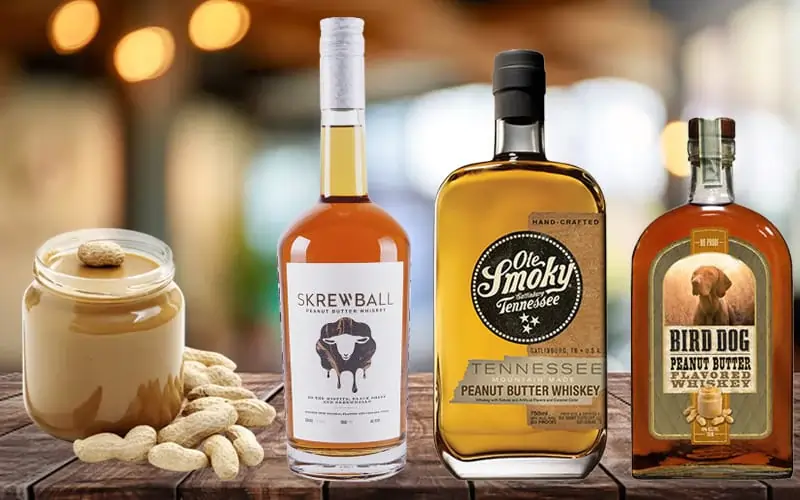
Here are some of the notable peanut butter whiskey brands:
- Skrewball Peanut Butter Whiskey: This brand is well-renowned for its creamy peanut butter whiskey. It offers a harmonious blend of sweet and savory flavors, combining smooth whiskey and creamy peanut butter[6][7].
- Sqrrl Peanut Butter Whiskey: Sqrrl offers a decadent peanut butter flavor with a touch of whiskey warmth. It has a smooth and velvety peanut butter flavor with hints of vanilla and caramel[1].
- Sheep Dog Peanut Butter Whiskey: Sheep Dog is another popular brand that offers a unique peanut butter whiskey. It’s known for its indulgent peanut butter flavor with notes of chocolate and caramel[1].
- Ole Smoky Peanut Butter Whiskey: Ole Smoky offers a peanut butter whiskey that is known for its rich and distinct taste. It captures the nutty sweetness of creamy peanut butter, giving the liquor a unique flavor[1].
- Skatterbrain Peanut Butter Whiskey: Skatterbrain is another brand that offers a peanut butter-infused whiskey. It’s known for its distinct peanut butter flavor and smooth finish[3].
- Two Trees Peanut Butter Whiskey: Two Trees offers a peanut butter whiskey that is known for its unique flavor profile. It’s a great choice for those looking for something different from traditional whiskey[5].
- Bird Dog Peanut Butter Whiskey: Bird Dog offers a peanut butter whiskey that is known for its distinct flavor. It’s made by infusing whiskey with natural peanut butter flavoring, resulting in a sweet and nutty taste[5].
Each brand has its own unique flavor profile, so it’s recommended to try a few to find your favorite. Whether you’re a fan of whiskey, peanut butter, or both, peanut butter whiskey offers a unique and exciting taste experience[5].
Peanut Butter Fudge Variations
Peanut butter fudge is a classic sweet treat that can be made in a variety of ways. Here are some variations and recipes for creating the perfect peanut butter fudge:
Easy Peanut Butter Fudge
- Ingredients: This recipe requires only four ingredients: butter, peanut butter, a pinch of salt, vanilla, and powdered sugar. The process involves combining butter and peanut butter in a saucepan and bringing it to a boil. Once it reaches boiling point, remove from heat and stir in the salt, vanilla extract, and powdered sugar. Spread it into a square pan and refrigerate until it sets[1].
- Variations: You can add chocolate chips or nuts for added texture and flavor[5].
World’s Best Peanut Butter Fudge
- Ingredients: This recipe uses white sugar, milk, butter, peanut butter, marshmallow creme, and all-purpose flour. The process involves combining sugar, milk, and butter in a saucepan, bringing it to a boil, and cooking for 5 minutes. After removing from heat, stir in peanut butter and marshmallow creme, then gradually mix in flour. Spread the fudge into a prepared dish and allow it to cool completely before slicing[2].
- Variations: You can experiment with different types of peanut butter or add in extras like chocolate chips or crushed cookies[2].
Easiest Peanut Butter Fudge
- Ingredients: This recipe calls for butter, brown sugar, confectioners’ sugar, milk, and vanilla extract. The process involves starting with a stick of butter, adding sugars and milk, and enhancing the overall flavor of the fudge with vanilla extract[3].
- Variations: You can add in extras like chocolate chips, nuts, or even marshmallows for a rocky road version[3].
Old-Fashioned Peanut Butter Fudge
- Ingredients: This recipe uses light brown sugar, powdered sugar, salted butter, and peanut butter. The process involves stirring the peanut butter and vanilla extract into the mixture until smooth and well combined, then adding the powdered sugar to a large bowl and pouring the hot peanut butter mixture over it. Beat together until combined and there are no lumps of powdered sugar remaining[5].
- Variations: You can add in different flavors like chocolate chips or nuts[5].
4 Ingredient Peanut Butter Fudge
- Ingredients: This recipe requires only four ingredients: butter, creamy peanut butter, vanilla, and powdered sugar. The process involves combining the peanut butter, butter, and vanilla in a glass bowl and melting in the microwave for 90 seconds. Stir to combine, then slowly add the powdered sugar a cup at a time[6].
- Variations: You can add in extras like chocolate chips, nuts, or even marshmallows for a rocky road version[6].
When making peanut butter fudge, consider using natural peanut butter to avoid added sugars and oils. Also, adjust the sweetness of your fudge by adding more or less sugar, and experiment with different add-ins and toppings to make your fudge your own. Enjoy your creamy and satisfying peanut butter fudge!
Types of Peanut Butter for Babies
When introducing peanut butter to babies, select styles minimizing salt and sugars:
| Type | Brand Examples | Texture | Mixing Tips |
|---|---|---|---|
| Smooth Peanut Butter | Skippy, Jif, Peter Pan | Smooth, no chunks | Can mix with breastmilk or formula to thin out at first |
| 100% Peanuts Peanut Butter | Smucker’s Natural, Trader Joe’s Creamy Unsalted | Thick and paste-like | Mix with liquids to thin for early introduction |
| Powdered Peanut Butter | Bell Plantation PB2, Nuts ‘N More | Requires adding water, thinner texture | Easy to swallow, can mix with milk or formula |
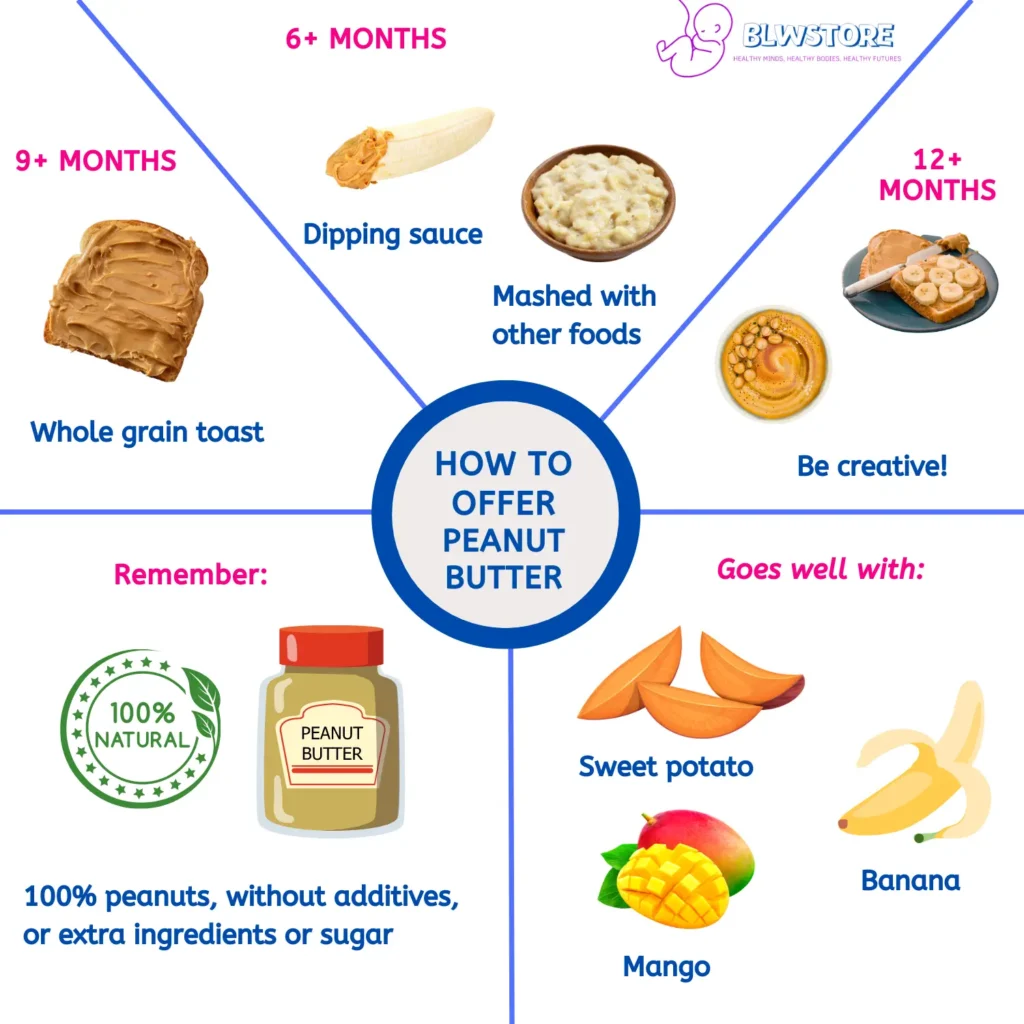
Smooth Peanut Butter – Smooth peanut butter with no added sugar is the best choice. The smooth texture with no chunks makes it easy for babies to eat and swallow. Major brands like Skippy, Jif, and Peter Pan all make smooth peanut butters specifically marketed for babies and toddlers.
100% Peanuts Peanut Butter – Look for 100% peanuts on the label with no added oils, sugars, or anything else. Brands like Smucker’s Natural and Trader Joe’s Creamy Unsalted are good choices. They have a thicker, paste-like texture.
Powdered Peanut Butter – Powdered peanut butter can be easier for some babies to handle. Brands like Bell Plantation PB2 and Nuts ‘N More natural peanut butter powder simply require adding water to turn into peanut butter. The texture may be thinner.
When first introducing peanut butter, mix a small amount with breastmilk or formula to thin down the texture. Only provide a thin coating on spoons or very thin pieces of toast cut into sticks or quarters to reduce choking risk.
By 9-12 months, smooth peanut butter can usually be provided freely, but powdered peanut butter may still be easier to swallow for some babies. Supervise feedings, especially with chunks or thick peanut butter.
Best Types of Peanut Butter for Babies
When introducing peanut butter to babies, it’s crucial to choose the right type to ensure it’s safe and nutritious. Here are some of the best types of peanut butter for babies:
365 Everyday Value Organic Peanut Butter
- This peanut butter is recommended due to its simple ingredient list: peanuts. It contains no extra salt, sugar, or additives, making it a safe and natural choice for babies[2].
Crazy Richard’s All Natural Peanut Butter
- This brand is known for its all-natural peanut butter, which is free from added sugars and salts, making it a healthy option for babies[8].
Thrive Market Organic Creamy Peanut Butter
- This peanut butter is organic and creamy, making it easy for babies to consume. It also doesn’t contain any added sugars or salts[8].
Smucker’s Natural Creamy Peanut Butter
- Smucker’s offers a natural creamy peanut butter that is free from added sugars and salts, making it a good choice for babies[10].
Santa Cruz Organic Peanut Butter
- This brand offers an organic peanut butter that is free from added sugars and salts, making it a safe and healthy option for babies[10].
Spread the Love Naked Peanut Butter
- This brand offers a peanut butter that is free from added sugars, salts, and preservatives, making it a good choice for babies[8].
When choosing peanut butter for babies, it’s important to select smooth varieties to prevent choking hazards. It’s also crucial to avoid peanut butter with added sugars, salts, and preservatives. Instead, opt for natural or organic varieties that contain only peanuts as the main ingredient.
Best Type of Peanut Butter for Acne Prone Skin
Peanut butter, especially those with added sugars and hydrogenated oils, can potentially trigger acne due to its high content of omega-6 fatty acids, which can cause inflammation and exacerbate acne.
However, it’s important to note that everyone’s skin may react differently to peanuts and peanut butter, and more research is needed to fully understand the effects of peanut butter on the skin.
If you have acne-prone skin and suspect that peanut butter might be worsening your condition, you might want to consider alternatives. Here are some acne-friendly alternatives to peanut butter:
- Macadamia Butter: Macadamia nuts are a good alternative to peanuts as they do not contain omega-6 fatty acids, which can trigger inflammation and acne[1][6].
- Sunflower Butter: Sunflower butter, made from roasted sunflower seeds, is another alternative that can actually help clear acne due to its Vitamin E content[1].
- Almond Butter and Cashew Butter: These nut butters are also considered acne-safe as they contain lesser inflammation-causing omega-6 fatty acids[2][4].
- Barney Butter: This is a non-gritty creamy smooth almond butter that is peanut-free, Paleo, Keto, Vegan, and gluten-free. It is also considered acne-safe[1][2].
When choosing a peanut butter or its alternative, look for options without added sugar or other sweeteners. A simple ingredient list that includes just the nuts and a small amount of salt is ideal[2]. It’s also recommended to monitor your skin’s reaction to different types of nut butters to determine which ones work best for you[8].
Best Peanut Butter Types for Dogs
Peanut butter can be a delicious treat for dogs, but it’s important to choose the right type to ensure it’s safe and healthy for your pet. Here are some of the best types of peanut butter for dogs:
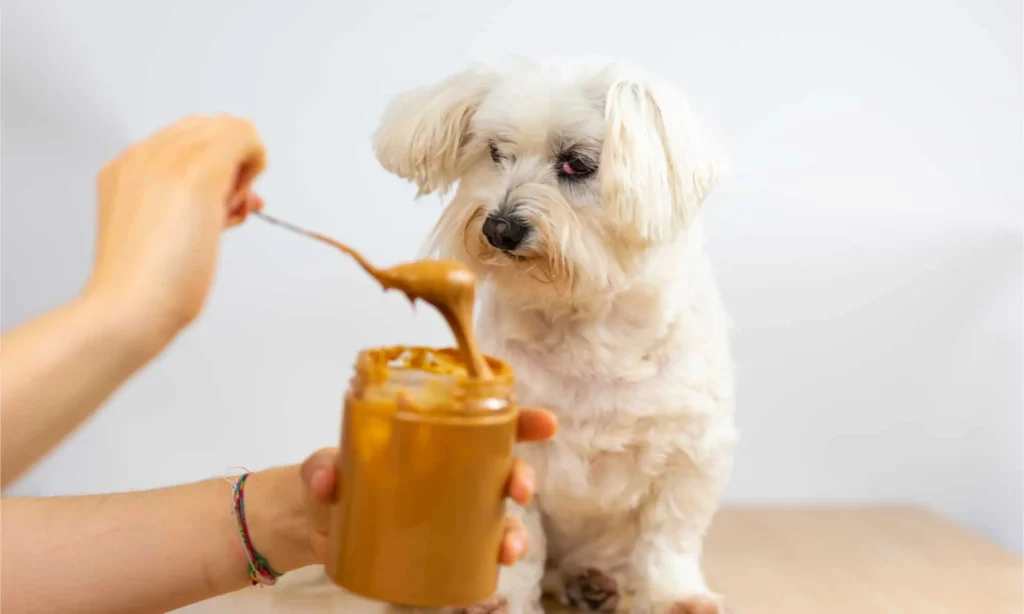
365 Everyday Value Organic Peanut Butter
- This peanut butter is a top pick for dogs due to its single ingredient: peanuts. It contains no extra salt, sugar, or additives, making it a safe and natural choice for dogs[8].
Poochie Butter Dog Peanut Butter
- This peanut butter is specifically formulated for dogs and includes health-boosting ingredients such as cinnamon for antifungal properties, ginger to aid digestion, and parsley to improve breath[3].
Bark Bistro Buddy Budder
- This brand offers a variety of flavors and its most basic offering, Ruff Ruff Raw, contains only dry-roasted unsalted peanuts and a dash of wildflower honey[6].
Teddie Super Chunky Peanut Butter
- While chunky peanut butter can pose a choking hazard for smaller dogs, if your dog prefers a bit of texture, this brand is a good choice. It’s recommended to always supervise your dog while they’re eating chunky peanut butter[5].
Green Coast Pet Pawnut Butter
- This peanut butter contains two simple ingredients, U.S.-grown unsalted peanuts and flaxseed. Flaxseed is a great source of omega-3 and omega-6 fatty acids, which support a dog’s overall health[6].
When choosing peanut butter for your dog, always check the ingredients list.
- The ideal peanut butter for dogs should contain only peanuts and maybe a small amount of salt.
- Avoid peanut butter with added sugars, artificial sweeteners, or xylitol, a sweetener that is toxic to dogs.
- Whether you choose creamy or crunchy may depend on your dog’s preferences, but creamy is generally safer and easier for them to eat.
Regardless of the brand, peanut butter should be given in moderation due to its high calorie and fat content.
Types of Peanut Butter in Smoothies
Nut butter loving smoothie makers have options:
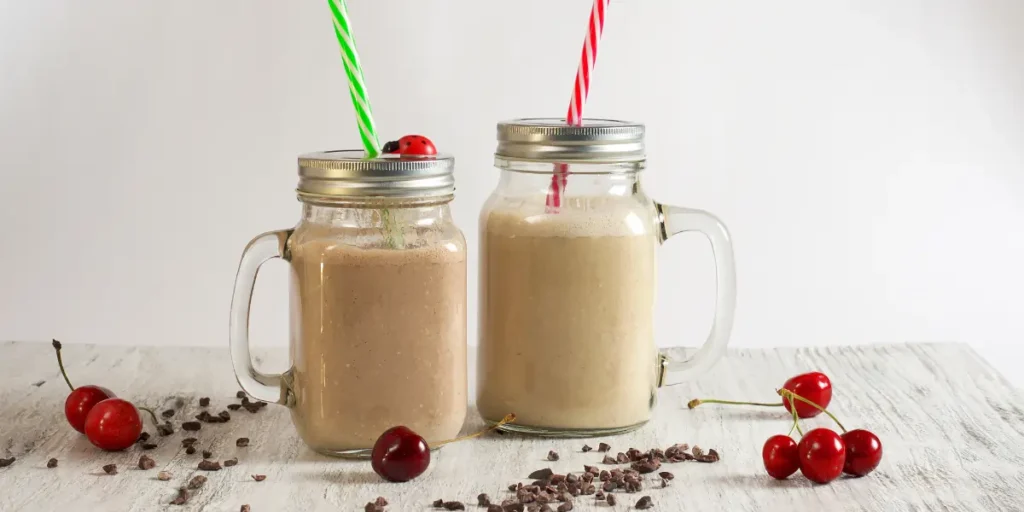
- Powdered – Mixes easily without altering texture
- Creamy – Classic style for nutrient boosting
- Natural – Deeper nut flavor when peanut essence desired
- Alternative nut – Almond butter lends pleasantly sweet undertone
- Sweetened – Banana and chocolate smoothies lean into the sweetness punched up peanut butter
Peanut Butter Smoothie Variations
Peanut butter smoothies are a delicious and nutritious option for a quick breakfast, a post-workout snack, or a healthy dessert. Here are some variations and tips for creating the perfect peanut butter smoothie:
Classic Peanut Butter Banana Smoothie
- Ingredients: Combine bananas, milk (dairy or non-dairy alternatives like almond milk), peanut butter, honey, and ice cubes in a blender[1].
- Variations: Add cocoa powder for a chocolate twist, or use frozen bananas for a thicker texture[3].
Strawberry Peanut Butter Smoothie
- Ingredients: Blend strawberries, Greek yogurt, milk, pineapple juice, peanut butter, and honey until smooth[2].
- Variations: For a vegan option, use non-dairy milk and yogurt. Add vanilla extract or maple syrup for extra flavor[6].
Chocolate Peanut Butter Banana Smoothie
- Ingredients: Use a frozen ripe banana, cacao or unsweetened cocoa powder, creamy natural peanut butter, and your choice of milk[8].
- Variations: For added nutrients, include flaxseed meal, hemp seeds, or a scoop of protein powder[8].
Oatmeal Peanut Butter Smoothie
- Ingredients: Combine oat milk, a chopped banana, peanut butter, rolled oats, and spices like cinnamon, allspice, and nutmeg[7].
- Variations: Freeze the banana for extra thickness or change up the milk to coconut, soy, or oat milk[5].
High-Protein Peanut Butter Smoothie
- Ingredients: Blend banana, frozen strawberries, peanut butter, Greek yogurt, and milk[12].
- Variations: Add sweetener if needed, or include chia seeds for fiber. Use water to thin the smoothie if desired[12].
Nutella Peanut Butter Smoothie
- Ingredients: Create a decadent smoothie by adding Nutella to the classic peanut butter and banana combination[12].
- Variations: Adjust the sweetness and consistency to your liking, and consider adding ice for a colder smoothie[12].
Green Peanut Butter Smoothie
- Ingredients: For a healthier twist, add spinach or kale to your peanut butter smoothie for an extra serving of veggies[2].
- Variations: Use vanilla or berry-flavored Greek yogurt to complement the greens[2].
Peanut Butter Coffee Smoothie
- Ingredients: Add a splash of cold brew coffee to your peanut butter smoothie for a caffeinated kick[.
- Variations: Mix in maca powder or vanilla protein powder for additional health benefits[11].
When making peanut butter smoothies, consider using natural peanut butter to avoid added sugars and oils. Also, adjust the thickness of your smoothie by adding more or less liquid, and sweeten to taste with natural sweeteners like honey or maple syrup. Experiment with different add-ins and toppings to make your smoothie your own. Enjoy your creamy and satisfying peanut butter smoothie!
What Types of Peanut Butter Contain Xylitol
An ingredient to absolutely avoid as highly toxic to dogs that’s unfortunately found in some peanut butters is: Xylitol artificial sweetener – check labeling carefully!
What Type of Peanut Butter Can Diabetics Eat
When managing blood sugar levels, prioritize natural peanut butter with limited sweeteners. The right matchup balances carb quantities and healthy fats.
What Type of Peanut Butter Can Hamsters Eat
Veterinarians caution against feeding peanut butter to hamsters given high fat content. But as occasional treat, small amount of creamy style recommended.
Alternative Nut Butters
While peanut butter is a beloved spread, there are several other nut butters that offer different flavors and nutritional profiles. Here’s a comparison of peanut butter with other popular nut butters:
Almond Butter
- Nutrition: Almond butter is slightly healthier than peanut butter because it has more vitamins, minerals, and fiber. It’s an excellent source of vitamin E, magnesium, and manganese, and also provides fiber, calcium, iron, a few B-vitamins, potassium, and zinc[1][4].
- Calories: Both almond and peanut butter are similar in terms of calories per ounce, with two tablespoons containing just under 200 calories[1].
- Fat Content: Almond butter contains more monounsaturated fat and less saturated fat than peanut butter[2].
- Protein: Peanut butter typically has a little more protein than almond butter[1].
Cashew Butter
- Nutrition: Cashew butter is lower in protein than peanut butter but is richer in other nutrients, including iron, copper, and phosphorus. It also has less sodium and sugar compared to peanut butter[2].
- Fat Content: Cashew butter contains heart-healthy unsaturated fats[2].
Other Nut Butters
- Pistachio Butter: Known for its mild flavor and nutrient boost, pistachio butter is a good source of antioxidants[3].
- Sunflower Seed Butter: Often used as a nut butter replacement for those with allergies, it provides fiber and healthy fats[6].
- Walnut Butter: Offers Omega-3 fatty acids and has anti-inflammatory properties[9].
When choosing between peanut butter and alternative nut butters, consider your dietary needs, health goals, and taste preferences. Almond butter is a great choice for those looking for extra vitamins and minerals, while cashew butter is a good option for those watching their sodium intake. Each nut butter has its own unique benefits and can be a part of a balanced diet.
Proper Storage of Peanut Butter
Peanut butter is a staple in many households, but proper storage is key to maintaining its freshness and flavor. Here are some tips for storing peanut butter:
Unopened Peanut Butter
- Conventional Peanut Butter: An unopened jar of conventional peanut butter can last 6-9 months in the pantry without refrigeration[11].
- Natural Peanut Butter: An unopened jar of natural peanut butter should be refrigerated immediately after purchase and can last up to 12 months[1].
Opened Peanut Butter
- Conventional Peanut Butter: Once opened, it can last up to 3 months in the pantry and up to 9 months in the refrigerator[2].
- Natural Peanut Butter: Opened natural peanut butter lasts for up to 6 months in the refrigerator[2]. It’s best consumed within 3-4 months of opening[1].
Storing Peanut Butter in the Pantry
- Location: Keep it away from heat sources like the oven to prevent spoilage[7].
- Upside-Down Storage: Store the jar upside down to help the oil distribute evenly and make stirring easier[7][10].
Storing Peanut Butter in the Refrigerator
- Texture: Refrigerating peanut butter can make it harder to spread, but it extends its shelf life[4].
- Natural Peanut Butter: Refrigeration is recommended for natural peanut butter to prevent oil separation and rancidity[1][4][5].
Containers for Peanut Butter
- Airtight Containers: Use airtight containers to keep peanut butter fresh and prevent it from absorbing odors[3][6].
- Glass Jars: Glass jars with tight-fitting lids are ideal for storing homemade peanut butter[6][12].
Freezing Peanut Butter
- Long-Term Storage: Peanut butter can be frozen to extend its shelf life. Thaw in the refrigerator before use[7].
Signs of Spoilage
- Smell and Taste: If peanut butter smells metallic, bitter, or stale, it may have gone bad[2].
- Appearance: Look for changes in color or texture, such as darkening or drying out[2].
By following these storage tips, you can ensure that your peanut butter remains fresh and delicious for as long as possible. Whether you prefer creamy or crunchy, conventional or natural, proper storage is the key to enjoying your peanut butter to the last spoonful.
Using Blenders and Food Processors for Homemade Peanut Butter
Making homemade peanut butter can be a simple and satisfying process, especially with the right equipment. Both blenders and food processors are capable of turning roasted peanuts into creamy peanut butter, but there are some differences in the process and the end result.
Food Processors for Peanut Butter
- Texture: Food processors typically produce a slightly grittier peanut butter compared to blenders[1][4].
- Process: Add roasted peanuts to the food processor and process until smooth, stopping to scrape down the sides as necessary. The process can take several minutes, and patience is key[3].
- Capacity: The amount of peanuts used should be proportionate to the size of the food processor to create a smooth, creamy spread[3].
- Advantages: Food processors have large blades and a wide area, which can be beneficial for achieving the desired texture[1].
Blenders for Peanut Butter
- Texture: High-powered blenders, like a Vitamix, can produce a very smooth and creamy peanut butter[4][5][8].
- Process: Start on a low speed to break up the peanuts and then increase to a higher speed until the peanut butter is completely smooth. The process can take a few minutes, and using a tamper can help press the peanuts into the blades[2][5][8].
- Advantages: Blenders can be easier to clean and may not require as much scraping down as food processors. Some users find that blenders produce a creamier peanut butter[4][5].
Tips for Both Appliances
- Roasted Peanuts: Use dry roasted peanuts for better flavor and easier oil release[5].
- Patience: Both appliances require time to transform the peanuts into peanut butter. It’s important to give the machine breaks to prevent overheating[3].
- Scraping: Regardless of the appliance, you’ll need to periodically scrape down the sides to ensure all peanuts are processed evenly[2][3].
Whether you choose a blender or a food processor, making homemade peanut butter is a straightforward process that results in a fresh and flavorful spread. Consider the texture you prefer and the equipment you have on hand when deciding which appliance to use.
Conclusion & Further Explorations
What a delicious journey through the diverse world of peanut butters! Beyond standard JIFs and SKIPPYs in familiar smooth or crunchy options, numerous styles emerge based on ingredients, textures, intended uses and creative flavoring. Hopefully this guide illuminated some new areas worth spreading yourself into (pun intended).
Share your own peanut butter opinions or explorations in the comments below! And make sure to stay tuned for future guides covering optimal pairing combinations and simple homemade recipes you can easily whip up using basic ingredients and a trusty blender. Now time to crack open that jar of crunchy goodness and grab a spoon!

